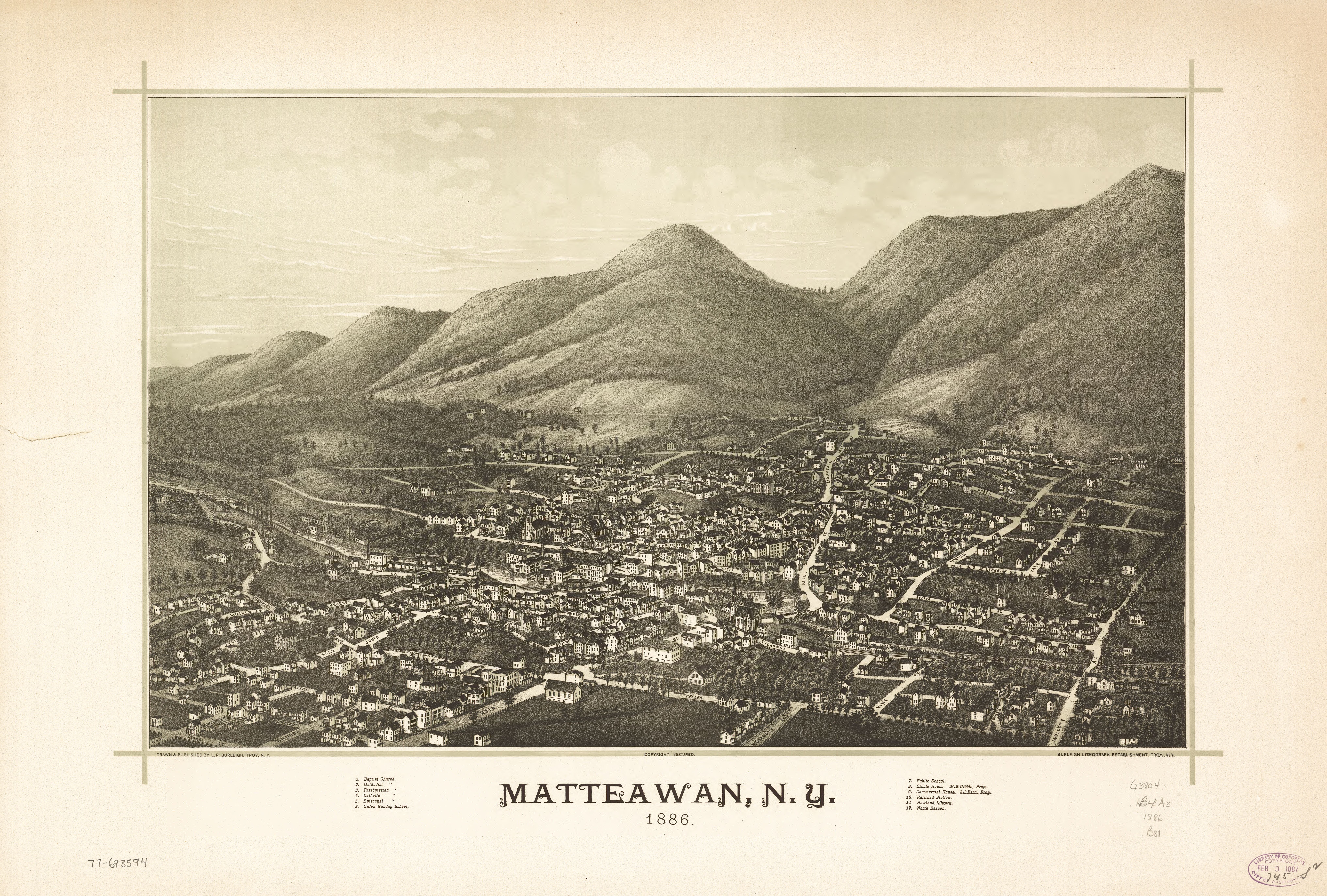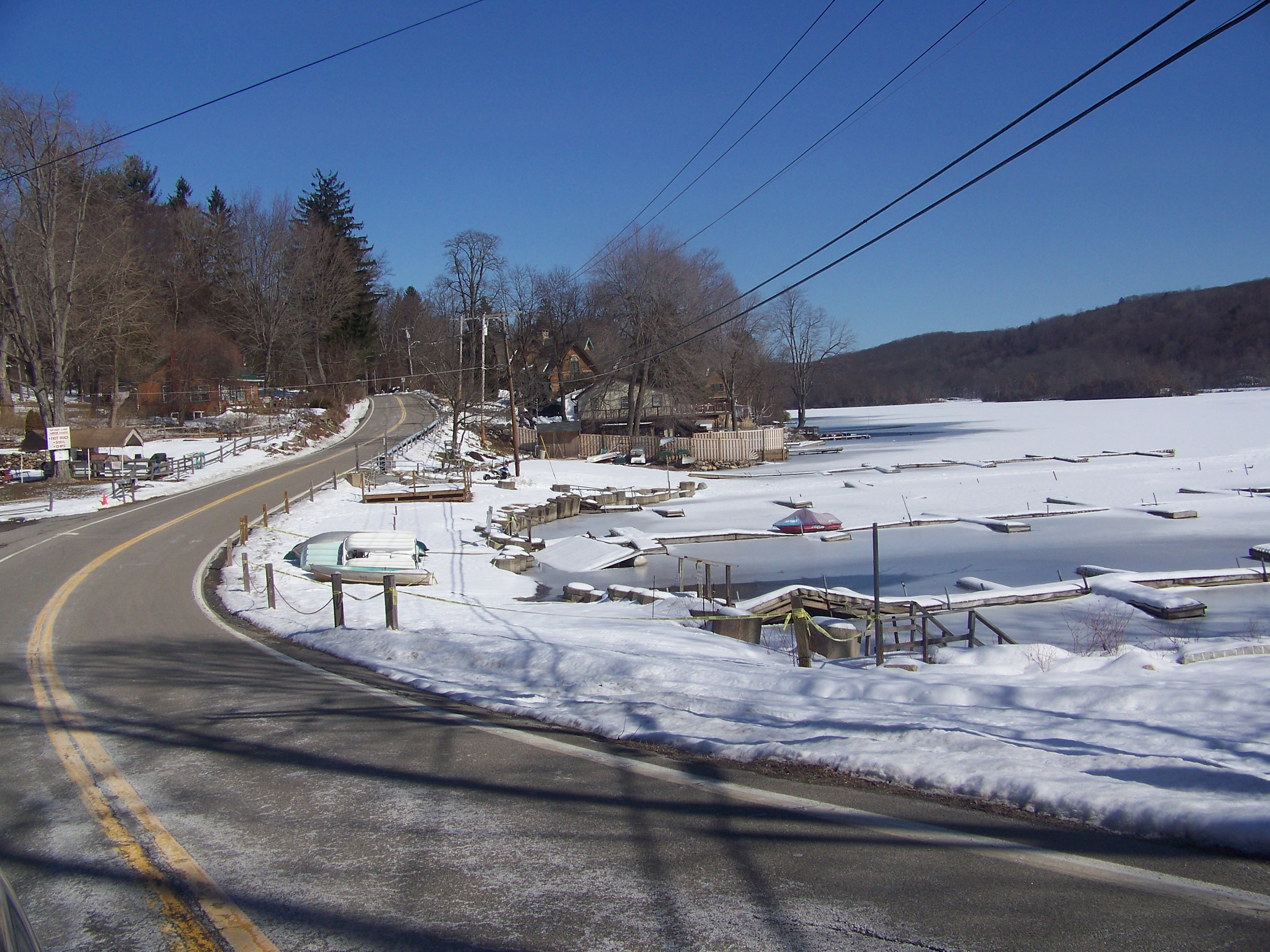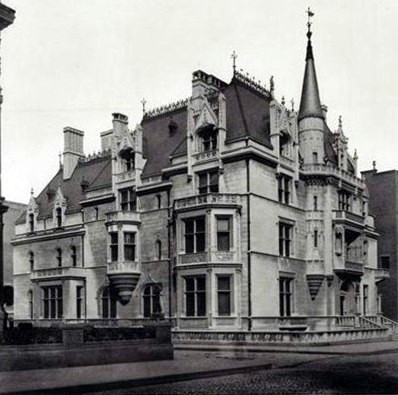|
United States Post Office (Beacon, New York)
The U.S. Post Office in Beacon, New York, is located on Main Street ( New York State Route 52 Business). It serves the ZIP Code 12508, covering the entire city of Beacon and some of the neighboring areas of the Town of Fishkill. It is a stone structure in the Dutch Colonial Revival architectural style built in the mid-1930s. In 1988 it was listed on the National Register of Historic Places along with many other older post offices in the state. While its style was not uncommon for post offices of the era, its fieldstone exterior is. Only a few other New Deal post offices in the state, most of them also in Dutchess County towns along the Hudson River, used it. President Franklin D. Roosevelt's preferred that new post offices in his native region echo the architectural preferences of his Dutch ancestors who had been among the earliest settlers of the Hudson Valley, and the success of the Beacon post office may have encouraged him in that respect. ''Note:'' This includes an''Acc ... [...More Info...] [...Related Items...] OR: [Wikipedia] [Google] [Baidu] |
Beacon, New York
Beacon is a city located in Dutchess County, New York, United States. The 2020 census placed the city total population at 13,769. Beacon is part of the Poughkeepsie– Newburgh– Middletown, New York Metropolitan Statistical Area as well as the larger New York– Newark–Bridgeport, New York–New Jersey–Connecticut–Pennsylvania Combined Statistical Area. Beacon was so named to commemorate the historic beacon fires that blazed forth from the summit of the Fishkill Mountains to alert the Continental Army The Continental Army was the army of the United Colonies (the Thirteen Colonies) in the Revolutionary-era United States. It was formed by the Second Continental Congress after the outbreak of the American Revolutionary War, and was establis ... of British troop movements. Originally an industrial city along the Hudson, Beacon experienced a revival beginning in 2003 with the arrival of Dia Beacon, one of the largest modern art museums in the United ... [...More Info...] [...Related Items...] OR: [Wikipedia] [Google] [Baidu] |
New York State Office Of Parks, Recreation And Historic Preservation
The New York State Office of Parks, Recreation and Historic Preservation (NYS OPRHP) is a state agency within the New York State Executive DepartmentParks, Recreation and Historic Preservation Law § 3.03. "The office of parks, recreation and historic preservation is hereby continued in the executive department. .. charged with the operation of state parks and historic sites within the U.S. state of New York. As of 2014, the NYS OPRHP manages nearly of public lands and facilities, including 180 state parks and 35 historic sites, that are visited by over 78 million visitors each year. History The agency that would become the New York State Office of Parks, Recreation and Historic Preservation (NYS OPRHP) was created in 1970; however, the history of state parks and historic sites in New York stretches back to the latter part of the 19th century. Management of state-owned parks, and guidance for the entire state park system, was accomplished by various regional c ... [...More Info...] [...Related Items...] OR: [Wikipedia] [Google] [Baidu] |
White Birch
''Betula papyrifera'' (paper birch, also known as (American) white birch and canoe birch) is a short-lived species of birch native to northern North America. Paper birch is named for the tree's thin white bark, which often peels in paper like layers from the trunk. Paper birch is often one of the first species to colonize a burned area within the northern latitudes, and is an important species for moose browsing. The wood is often used for pulpwood and firewood. Description It is a medium-sized deciduous tree typically reaching tall, and exceptionally to with a trunk up to in diameter. Within forests, it often grows with a single trunk but when grown as a landscape tree it may develop multiple trunks or branch close to the ground. Paper birch is a typically short-lived species. It handles heat and humidity poorly and may live only 30 years in zones six and up, while trees in colder-climate regions can grow for more than 100 years. ''B. papyrifera'' will grow in many soi ... [...More Info...] [...Related Items...] OR: [Wikipedia] [Google] [Baidu] |
Coniferous Trees
Conifers are a group of cone-bearing seed plants, a subset of gymnosperms. Scientifically, they make up the division Pinophyta (), also known as Coniferophyta () or Coniferae. The division contains a single extant class, Pinopsida. All extant conifers are perennial woody plants with secondary growth. The great majority are trees, though a few are shrubs. Examples include cedars, Douglas-firs, cypresses, firs, junipers, kauri, larches, pines, hemlocks, redwoods, spruces, and yews.Campbell, Reece, "Phylum Coniferophyta". Biology. 7th. 2005. Print. P. 595 As of 1998, the division Pinophyta was estimated to contain eight families, 68 genera, and 629 living species. Although the total number of species is relatively small, conifers are ecologically important. They are the dominant plants over large areas of land, most notably the taiga of the Northern Hemisphere, but also in similar cool climates in mountains further south. Boreal conifers have many wintertime adaptations. T ... [...More Info...] [...Related Items...] OR: [Wikipedia] [Google] [Baidu] |
Woodlot
A woodlot is a parcel of a woodland or forest capable of small-scale production of forest products (such as wood fuel, sap for maple syrup, sawlogs, and pulpwood) as well as recreational uses like bird watching, bushwalking, and wildflower appreciation. The term ''woodlot'' is chiefly North American; in Britain, a woodlot would be called a wood, woodland, or copse. Many woodlots occur as part of a farm or as buffers and undevelopable land between these and other property types such as housing subdivisions, industrial forests, or public properties (highways, parks, watersheds, etc.). Very small woodlots can occur where a subdivision has not met its development potential, or where terrain does not easily permit other uses. Very large woodlots (hundreds of acres) might emerge where profitable wood species have been depleted by commercial logging practices or compromised by diseases, leaving little choice but to divide and liquidate the real estate for other purposes. One disting ... [...More Info...] [...Related Items...] OR: [Wikipedia] [Google] [Baidu] |
Madam Brett Homestead
The Madam Brett Homestead is an early 18th-century home located in the city of Beacon, New York, United States. It is the oldest standing building in this part of Dutchess County and has been listed in the National Register of Historic Places since 1976. It is also listed on the NYS Independence Trail. Madam Brett Catheryna Rombout Brett (1687–1764) was the daughter of Helena Teller Bogardus Van Ball Rombout and Francis Rombout. Helena Teller was the daughter of William Teller, of Albany, one of the original patent holders of the area around Schenectady. Francis Rombout served as a lieutenant during Stuyvesants' expedition against New Sweden. In partnership with Gulyne Verplank, Rombout became a successful merchant-fur trader, and in 1679, Mayor of New York. In 1683, Rombout and Verplanck purchased about 85,000 acres from the Wappinger native Indians. The purchased was confirmed, 17 October 1685 as the royal Rombout Patent issued by King James II to Francis Rombout, Jacob ... [...More Info...] [...Related Items...] OR: [Wikipedia] [Google] [Baidu] |
Fishkill Creek
Fishkill Creek (also Fish Kill, from the Dutch ''vis kille'', for "fish creek") is a tributary of the Hudson River in Dutchess County, New York, United States. At U.S. Geological Survey. National Hydrography Dataset high-resolution flowline dataThe National Map , accessed October 3, 2011 it is the second longest stream in the county, after Wappinger Creek. It rises in the town of Union Vale and flows generally southwest to a small estuary on the Hudson just south of Beacon. Part of its watershed is in Putnam County to the south. Sprout Creek, the county's third-longest creek, is its most significant tributary. Whaley and Sylvan lakes and Beacon Reservoir, its largest, deepest and highest lakes, are among the bodies of water within the watershed. While the creek is not impounded for use in any local water supply, it remains a focus of regional conservation efforts as a recreational and aesthetic resource, especially since the lower Fishkill watershed has been extensively develo ... [...More Info...] [...Related Items...] OR: [Wikipedia] [Google] [Baidu] |
Richard Morris Hunt
Richard Morris Hunt (October 31, 1827 – July 31, 1895) was an American architect of the nineteenth century and an eminent figure in the history of American architecture. He helped shape New York City with his designs for the 1902 entrance façade and Great Hall of the Metropolitan Museum of Art, the pedestal of the Statue of Liberty (''Liberty Enlightening the World''), and many Fifth Avenue mansions since destroyed. Hunt is also renowned for his Biltmore Estate, America's largest private house, near Asheville, North Carolina, and for his elaborate summer cottages in Newport, Rhode Island, which set a new standard of ostentation for the social elite and the newly minted millionaires of the Gilded Age. Early life Hunt was born at Brattleboro, Vermont into the prominent Hunt family. His father, Jonathan Hunt, was a lawyer and U.S. congressman, whose own father, Jonathan Hunt, senior, was lieutenant governor of Vermont. Hunt's mother, Jane Maria Leavitt, was the daughter o ... [...More Info...] [...Related Items...] OR: [Wikipedia] [Google] [Baidu] |
Google Maps
Google Maps is a web mapping platform and consumer application offered by Google. It offers satellite imagery, aerial photography, street maps, 360° interactive panoramic views of streets ( Street View), real-time traffic conditions, and route planning for traveling by foot, car, bike, air (in beta) and public transportation. , Google Maps was being used by over 1 billion people every month around the world. Google Maps began as a C++ desktop program developed by brothers Lars and Jens Rasmussen at Where 2 Technologies. In October 2004, the company was acquired by Google, which converted it into a web application. After additional acquisitions of a geospatial data visualization company and a real-time traffic analyzer, Google Maps was launched in February 2005. The service's front end utilizes JavaScript, XML, and Ajax. Google Maps offers an API that allows maps to be embedded on third-party websites, and offers a locator for businesses and other organizations in numero ... [...More Info...] [...Related Items...] OR: [Wikipedia] [Google] [Baidu] |
Howland Cultural Center
The Howland Cultural Center, formerly known as Howland Library, is located on Main Street ( New York State Route 52 Business) in Beacon, New York, United States. It is an ornate brick building designed by Richard Morris Hunt in the 1870s. In 1973 it was listed on the National Register of Historic Places. Hunt was commissioned by his brother-in-law, Joseph Howland, to design a home for a subscription library he donated to the city. The completed building has much in common with the Stick style summer homes in Newport, Rhode Island, that Hunt designed at this early stage of his career. Some of its design elements have been compared to Norwegian vernacular architecture. The interior was not complete in its current form until almost the end of the century. Except for some upgrades to its utilities, it has remained largely intact since then. Throughout the 1920s it was one of only two remaining public subscription libraries in the state. In response to a donor's bequest, the library ... [...More Info...] [...Related Items...] OR: [Wikipedia] [Google] [Baidu] |
Lower Main Street Historic District (Beacon, New York)
The Lower Main Street Historic District is a historic district comprising the first several blocks of Main Street ( NY 52 Business) in Beacon, east of its intersection with South Street, the end of its concurrency with NY 9D. The southeast end is at Teller Avenue. The District covers about 50 acres (20 ha.) and includes 32 buildings, most of them in the late 19th-century Italianate style. ''See also:'' Many of these buildings have been extensively renovated and are now used for businesses such as boutiques and art galleries. The Beacon Institute for Rivers and Estuaries currently has its home in one of the buildings. The District was added to the National Register of Historic Places The National Register of Historic Places (NRHP) is the United States federal government's official list of districts, sites, buildings, structures and objects deemed worthy of preservation for their historical significance or "great artistic ... in 1987. Contributing properties The form ... [...More Info...] [...Related Items...] OR: [Wikipedia] [Google] [Baidu] |
Western United States
The Western United States (also called the American West, the Far West, and the West) is the region comprising the westernmost states of the United States. As American settlement in the U.S. expanded westward, the meaning of the term ''the West'' changed. Before about 1800, the crest of the Appalachian Mountains was seen as the western frontier. The frontier moved westward and eventually the lands west of the Mississippi River were considered the West. The U.S. Census Bureau's definition of the 13 westernmost states includes the Rocky Mountains and the Great Basin to the Pacific Coast, and the mid-Pacific islands state, Hawaii. To the east of the Western United States is the Midwestern United States and the Southern United States, with Canada to the north, and Mexico to the south. The West contains several major biomes, including arid and semi-arid plateaus and plains, particularly in the American Southwest; forested mountains, including three major ranges, the ... [...More Info...] [...Related Items...] OR: [Wikipedia] [Google] [Baidu] |





